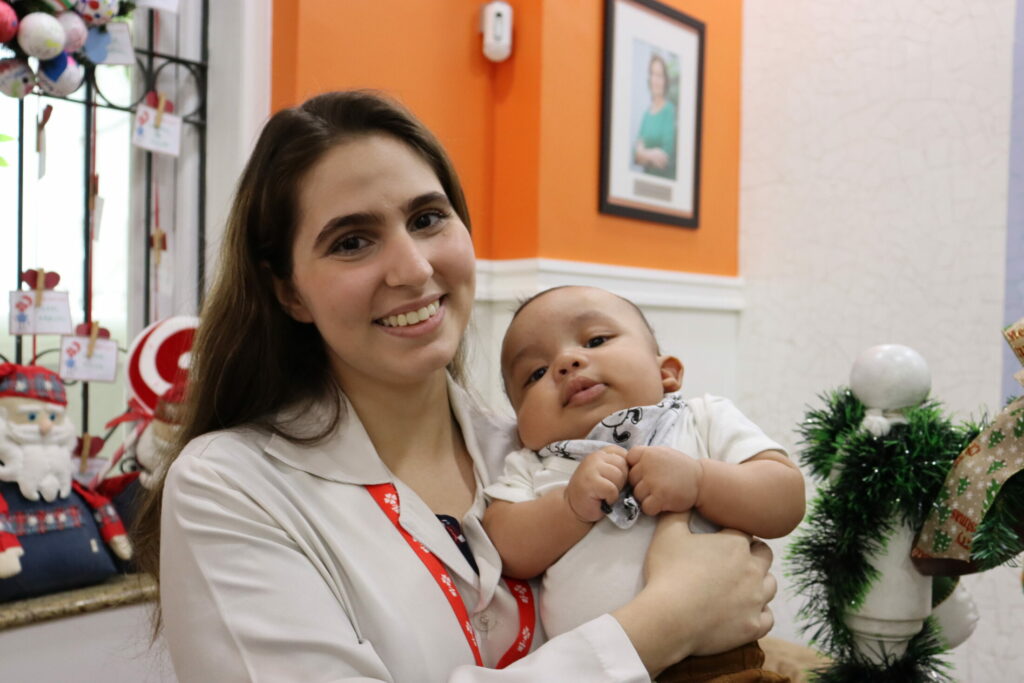How to care for baby teeth?
How to care for baby teeth?
30/04/2024
“Care for the baby teeth of a child with heart disease is the same as for the baby teeth of a child without any heart problems”, explains Bartira Volschan, a pediatric dentist who has been part of the team of volunteer dentists at Pro Criança Cardiac for over 15 years. years. But, as heart disease can be aggravated by a dental problem, parents’ attention to the hygiene and nutrition of a child with heart disease needs to be doubled. Infection in a baby tooth with deep cavities can be an infectious focus and spread through the bloodstream, causing consequences for the child’s general health, even more so in children with heart problems.
It is necessary to take this reality into consideration when, to please the child, parents end up giving bottles and sugary snacks instead of normal food and are not so demanding when it comes to hygiene so as not to displease them, or to prevent them from crying.
We looked for Dr. Bartira to talk specifically about baby teeth because many people believe that taking care of them is not that necessary, as they will fall out anyway. But this reasoning can harm a child’s health and their adult life, did you know? Baby teeth are important for performing all the functions of speech and chewing food, and also for maintaining adequate space for the arrival of the permanent tooth, as it acts as a guide for it.
“What parents and families do at home to take care of their children’s teeth is much more important than what I do in the office. I always tell them that”, says the dentist, as cavity lesions can become chronic. But, to achieve this, it is very important that the habits that led to cavities are changed.
Let’s learn?
CARE OF BABY TEETH
FOOD
According to Dr. Bartira, sugar is a cariogenic food, that is, it causes cavities, and must be controlled. In very young children, the biggest source of sugar comes from drinking bottles, which contain sugar, honey and sweetened flour products. And, even if the child continues to breastfeed, but eats cookies and drinks sugary juices, they may get cavities. Until the age of two, sugar consumption should be avoided. Instead, the family should offer fruits to the child, which have lots of fiber and encourage chewing, helping the teeth to develop.
Furthermore, when a child chews, it stimulates the production of saliva, which is a fluid in our body with enzymes and proteins capable of fighting bacteria that cause cavities. Hard foods are also welcome, as in addition to promoting chewing and producing more saliva, friction with the teeth helps to clean them. “In general, in addition to contributing to the balance of oral health, a balanced diet is essential for the complete development of the child”, highlights Dr. Bartira.
HYGIENE
First teeth in babies
When there are no teeth in the mouth, it is unnecessary to clean babies’ mouths after feedings. This is because, when the child is born, its oral flora (microorganisms in the mouth) are new. The more manipulation there is, the more it can facilitate the entry of opportunistic fungi. Cleaning starts with the first teeth. If this habit is postponed, when the child is two years old they will resort to brushing, as it will be strange for them.
How to make?
Hygiene of the first teeth can be done with gauze wrapped around the finger or with a separate cloth for this purpose. “Children find it more enjoyable when we moisten them with ice-cold filtered water,” says Dr. Bartira. An important detail is the facial expression of the person performing this cleaning. “It is very important that the child associates it with a pleasant habit, not with aggression, so smile at him. Cleaning can be done after bathing, on the changing table. When she gets older, giving her a brush to play with is a way of creating a relationship with the object (and having another one that isn’t all bitten off to do the hygiene itself)”, highlights the dentist.
Those responsible can follow a cleaning order so as not to forget any teeth: start with the lower teeth and then move on to the upper teeth. The front teeth are called incisors (central and lateral) “For these eight teeth, cleaning with gauze is sufficient. In the case of molars, the back teeth, which are thicker and have little scratches on the chewing part, the gauze is not as effective and the introduction of the brush is important. Even with the aim of creating an educational process: he ate, he got his teeth dirty, so let’s clean it”, he emphasizes.
oothpaste?
Dr. Bartira advises that, if there is sugar in the diet, the fluoride paste needs to be introduced into the child’s hygiene routine (more than 1000ppm of F, look at the packaging and check if the amount of fluoride is recommended). In what quantity? For children who do not know how to spit, under three years of age, just the equivalent of a grain of raw rice, twice a day. It’s really very little, because the fluoride contained in the pastes is a medicine and the child should not ingest it in large quantities. A guardian must put the amount of paste on the brush for the child.
“Excess foam makes you feel clean, but what really cleans is the brush. You need to count to 10 for each side of the tooth, as the bacteria produce a powerful glue that only comes out with good brushing”, highlights the pediatric dentist. From the age of three, when the child learns to spit, the amount of 1 bean is offered.
From the age of four…
At this stage, children begin to be more interested in brushing their teeth alone, so parents can encourage this independence as long as it is supervised by a responsible person. Remember that children acquire the motor skills for proper brushing movements at the age of six or seven, as it is the same skill for writing. It is important to highlight that parents must be responsible for performing oral hygiene at least once a day.
And the dental floss?
The time to introduce dental floss is when the teeth come together. “If you are a baby and have teeth close together, yes, you need to floss your teeth. Cavities that occur between the teeth are difficult to diagnose clinically, in many cases only with radiography to check, and it is tedious to restore, so it is good to prevent it from happening”, advises Bartira.
The ideal is to use it every night, otherwise the bacterial plaque can become thick, produce acid and corrode the tooth, which is how cavities appear. If your child consumes a lot of sugar, then you need to thread it every day. It is worth remembering that the ability to floss begins around 10 years of age.
Did you like it?
Dr. Bartira gave us a real lesson, do you agree?
Recommend to other mothers, other families!
Let’s, together, take care of our children’s oral health and help ensure smiles with perfect teeth in the future.
Related articles

The 2025 World Top SGOs Are Live

Pro Criança Cardíaca has already secured its registration for the 2025 Best NGOs Award
